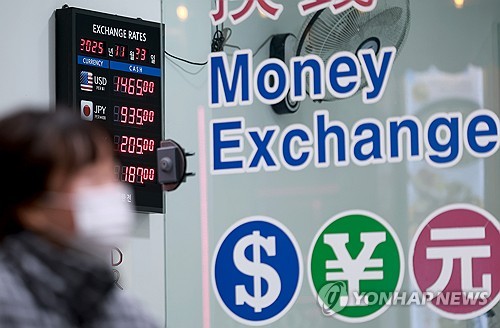
(Seoul=Yonhap Infomax) Ji Yeon Kim – Despite efforts by South Korean authorities to stabilize the foreign exchange market, the dollar-won exchange rate has surged back to the upper 1,470 won range, drawing attention to whether policymakers will step in to curb further volatility.
According to Yonhap Infomax’s dollar-won trading summary (screen number 2110) on the 24th, the dollar-won rate climbed to 1,476 won during regular trading on the 21st, marking its highest level since the yearly peak of 1,487.60 won on April 9.
Heavy net selling by foreign investors in the KOSPI market—exceeding 2.8 trillion won ($2.1 billion) in a single day—triggered increased demand for dollars from custodians, intensifying upward pressure on the exchange rate.
Additionally, the widening gains in the Taiwan dollar exchange rate contributed to a synchronized move in the dollar-won rate.
During after-hours extended trading, the rate briefly spiked to 1,477.90 won, opening the door for further upside.
Market participants note that authorities have more leeway to intervene during periods of relative calm, rather than when the exchange rate is rising sharply.
“After the authorities issued verbal intervention on the 14th, the exchange rate quickly jumped from the 1,450 won range to the 1,470s within a few days,” said a source in the foreign exchange market. “Typically, authorities monitor the situation during sharp moves and act more decisively when the market quiets down.”
The source added, “There is a possibility of intervention when dollar-buying momentum subsides. Authorities are likely waiting for the right timing.”
On the same day, the dollar-yen rate fell below the 157 yen level due to a reversal in yen short positions, but found support in the 156 yen range, maintaining an overall weak trend for the Japanese currency.
As a result, market observers believe immediate intervention by South Korean authorities is unlikely, given that the yen—often seen as a proxy for the won—remains weak.
“Authorities have repeatedly voiced concerns about the high exchange rate, but they are unable to act while the dollar-yen remains elevated,” said a foreign exchange dealer at a securities firm.
“If the dollar-yen approaches 160, even direct intervention by the Bank of Korea could be ineffective, as the rate may quickly rebound. Unless South Korea and Japan coordinate their actions, a sharp drop in the exchange rate is unlikely,” the dealer added.
Previously, on April 16 last year, the finance ministers of South Korea and Japan issued a joint verbal intervention in response to sharp declines in the won and yen. At that time, Choi Sang-mok, Deputy Prime Minister and Minister of Economy and Finance, and Shunichi Suzuki, Japan’s Finance Minister, met in Washington, D.C. during the G20 Finance Ministers and Central Bank Governors Meeting, stating their readiness to take appropriate measures against excessive foreign exchange volatility.
This was possible as both countries held a series of finance ministerial meetings.
Currently, while the heads of both countries’ foreign exchange authorities have expressed concerns over currency weakness, the lack of active finance ministerial talks makes a joint “firefighter” intervention unlikely.
Meanwhile, the Japanese government on the 21st approved a comprehensive economic stimulus package worth 21.3 trillion yen ($141 billion), with the specific size of the supplementary budget to be finalized by the 28th.
Experts agree that the upper bound for the exchange rate will likely remain open at least until the 28th.
Shinhan Investment Corp. noted in a report, “While both stimulus effects and inflationary pressures are at play for the yen, we expect the exchange rate to remain sticky on the downside until the supplementary budget is finalized on the 28th.”
Min Kyung-won, economist at Woori Bank, said, “The domestic stock market is undergoing a correction, and risk-off sentiment in growth stocks persists, making the exchange rate highly sensitive to upward moves in this asymmetric structure. The previous high of 1,480 won is clearly within reach, and even 1,500 won is now in sight.”
He added, “With the dollar index at 100, exporters have little incentive to sell dollars, so the upper bound for the exchange rate is likely to remain open in the short term.”
jykim2@yna.co.kr
(End)
Copyright © Yonhap Infomax Unauthorized reproduction and redistribution prohibited.

